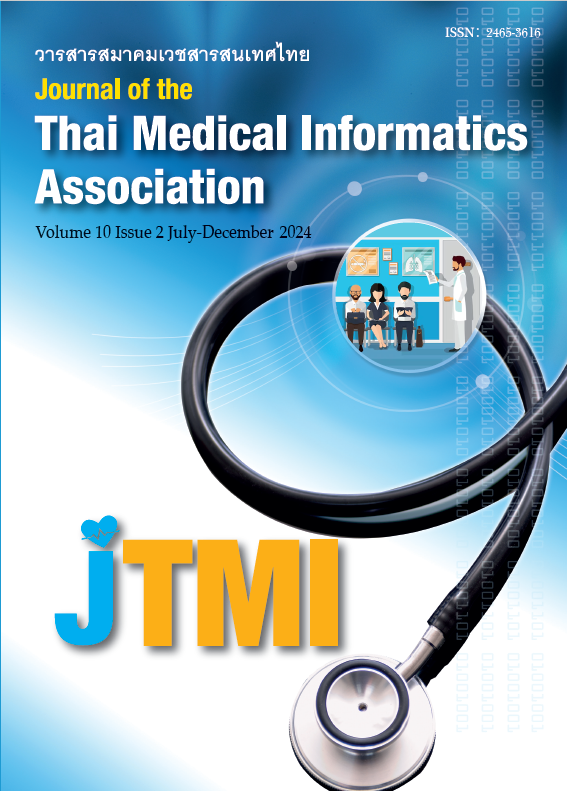Reducing waiting times for outpatient services Orthopedic Department Bamrasnaradura Infectious Diseases Institute by simulating the situation of dividing patients for examination according to the appointment period
Keywords:
Reduce waiting time, Stimulation model, Hospital service systemAbstract
Long waiting times before receiving treatment is a common problem in both government and private hospitals. This affects the patient's level of satisfaction with the service. There are an average of 50 patients per day at outpatient orthopedic department at Bamrasnaradura Infectious Diseases Institute. The service time according to normal service procedures is an average of 3.90 hours per person (234 minutes per person). The longest waiting time takes up to 4.95 hours (297 minutes). The objective of this study was to compare the service time for patients between the group that undergoes time-based scheduling and the group that receives services in the traditional format by using simulation models. It aims to reduce patient waiting time. From the results of the study, it was found that patients who were allocated time for examination in all groups had a shorter waiting time (30.66 to 68.44 %) compared to the group of patients who received traditional services. From this study, it is still not possible to tell the level of satisfaction of patients in receiving services. If the time allocation process is implemented, there should be a comparison of patient satisfaction as well.
References
Trout, A. R. Magnusson, and J. R. Hedges, "Patient satisfaction investigations and the emergency department: what does the literature say?," (in eng), Acad Emerg Med, vol. 7, no. 6, pp. 695-709, Jun 2000.
Bleustein, D. B. Rothschild, A. Valen, E. Valatis, L. Schweitzer, and R. Jones, "Wait times, patient satisfaction scores, and the perception of care," (in eng), Am J Manag Care, vol. 20, no. 5, pp. 393-400, May 2014.
McIntyre and C. K. Chow, "Waiting Time as an Indicator for Health Services Under Strain: A Narrative Review," (in eng), Inquiry, vol. 57, p. 46958020910305, Jan-Dec 2020.
Bahadori, E. Teymourzadeh, R. Ravangard, and M. Raadabadi, "Factors affecting the overcrowding in outpatient healthcare," (in eng), J Educ Health Promot, vol. 6, p. 21, 2017.
Cayirli and E. Veral, "Outpatient scheduling in health care: a review of literature," Production and operations management, vol. 12, no. 4, pp. 519-549, 2003.
งานเวชระเบียนสถาบันบำราศนราดูร, "ข้อมลู และสถิติ ผู้ป่วยนอกแผนกศัลยกรรมกระดูกและข้อ สถาบันบำราศ นราดูร ปีงบประมาณ 2566," 2023.
ว. รักผกาวงศ์, จ. สาชะรุง, ร. ทวีเฉลิมดิษฐ์, อ. ฉันทวุฒิ นันท์, ธ. ฉัตรทวีลาภ, and ภ. ปริญญารักษ์, "ระยะ เวลาการรอคอยและระยะเวลารับบริการแผนกผู้ป่วยนอก โรงพยาบาลทั่วไปขนาดกลางภาคเอกชนแห่งหนึ่ง," เภสัชกรรม คลินิก, vol. 27, no. 2, pp. 53-63, 2021.
ป. เรือนเพ็ง, "การจำลองระบบแถวคอยแผนกผู้ป่วยนอก : กรณีศึกษาคลินิกอายุรกรรม โรงพยาบาลพัทลุง," Veridian E-Journal, Silpakorn University (Humanities, Social Sciences and arts), vol. 6, no. 3, pp. 834-845, 2013.
ว. จันทร์เจริญกิจ, ป. เสงี่ยมสุนทร, and บ. จันทร์สว่าง, "การจำลองระบบแถวคอยสำหรับบริการผู้ป่วยนอก : กรณี ศึกษาคลินิกเบาหวานแผนกผู้ป่วยนอก โรงพยาบาลสมเด็จ พระพุทธเลิศหล้า," Thai Science and Technology Journal, pp. 71-79, 2018.
ป. มั่นเหมาะ and ธ. วสุศรี, "การจำลองสถานการณ์ เพื่อลดเวลารอคอยของผู้ป่วยแผนกผู้ป่วยนอก โรงพยาบาล ชุมชน จังหวัดสุพรรณบุรี," Isan Journal of Pharma ceutical Sciences, vol. 15, no. 2, pp. 51-62, 2019.
เ.ชำนาญหล่อ, ก. สุขสานต์, and จ. สายบุญณะ, "การ จำลองสถานการณ์เพื่อเพิ่มประสิทธิภาพการให้บริการของ แผนกผู้ป่วยนอก โรงพยาบาลแหลมฉบัง," Srinakharin wirot University Engineering Journal, vol. 13, no. 1, pp. 166-175, 2018.






